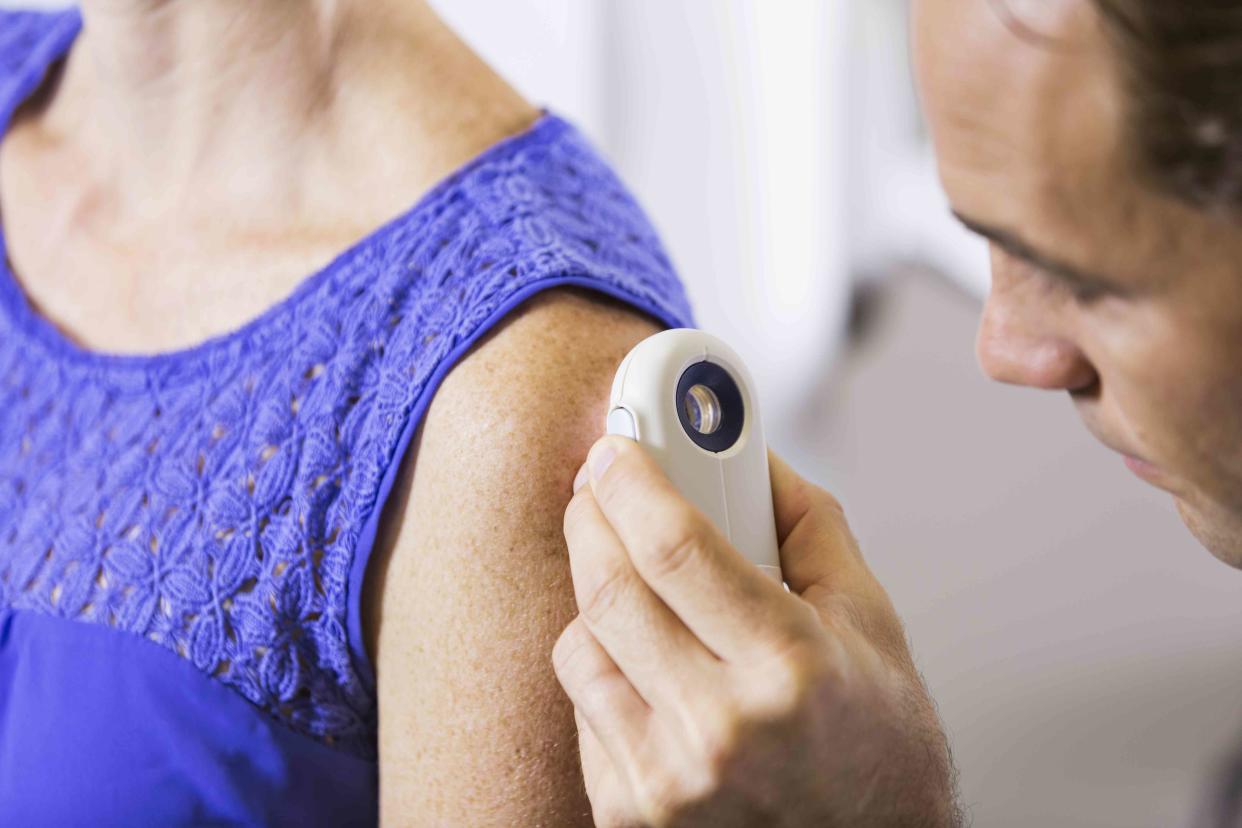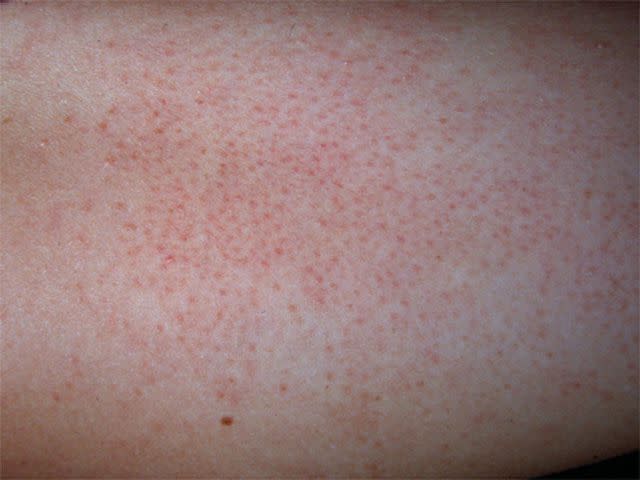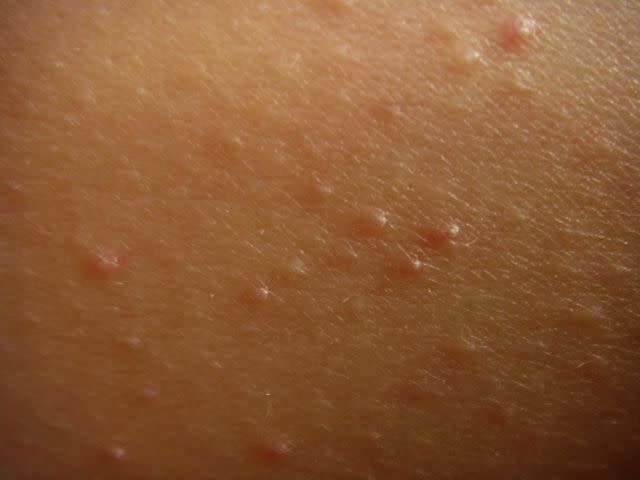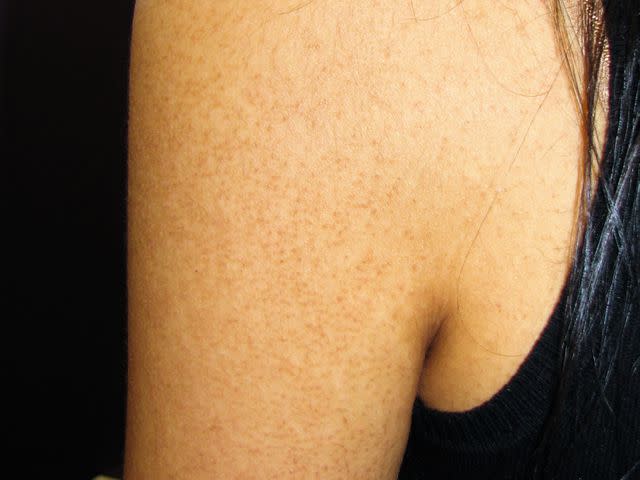What Is Keratosis Pilaris?

kali9 / Getty Images
Medically reviewed by Susan Bard, MD
Keratosis pilaris, sometimes called “chicken skin,” is a common condition that appears as small, rough bumps resembling goosebumps. It's most commonly found on the cheeks, upper arms, thighs, and buttocks, but it can appear on any part of the skin.
Keratosis pilaris, or KP, is benign (harmless). It often first appears during childhood and affects up to 50-58% of adolescents and about 40% of adults. It tends to be more common in people with dry skin and may worsen during winter when the air is drier. If it develops during the teenage years, it usually clears by age 30.
Keratosis pilaris can sometimes cause itchiness and may be a source of self-consciousness. You can't cure it or prevent it, but you can treat it. Treatment options include moisturizing the affected areas, gently exfoliating, and using topical creams or lotions containing ingredients like urea or lactic acid to help soften skin.
Types
Keratosis pilaris is classified into subtypes based on its appearance and symptoms. This helps healthcare providers determine the most appropriate treatment.
Keratosis Pilaris Rubra (KPR)
This subtype is characterized by inflamed, red, grain-like bumps that can cause itching or burning sensations. KPR appears on the face, torso, and arms and often gives the cheeks a flushed appearance. Unlike other subtypes, this subtype often persists beyond puberty.

Dermnet NZ
Keratosis Pilaris Alba
KPA causes dry, rough, bumpy skin without significant redness or inflammation. The bumps are usually flesh-colored or grayish-white, and the affected areas may feel dry and scaly.

Dermnet NZ
Keratosis Pilaris Atrophicans (KPA)
This rare subtype is characterized by depressed or indented scars or pits that appear after plugged hair follicles are shed. It can lead to scarring and permanent changes in skin texture. It may result in alopecia (hair loss) over time, particularly around the eyebrows.
Keratosis pilaris atrophicans faciei (KPAF) is often considered a form of KPA. It's characterized by tiny papules on the forehead, eyebrows, chin, and cheeks. It leads to tiny depressions and permanent hair loss in affected areas.

Dermnet NZ
Related: Strawberry Legs: What They Are and How To Treat Them
Symptoms
The main symptom of keratosis pilaris is the presence of small, rough bumps on the skin. These bumps may look similar to goosebumps or have a “chicken skin” texture. They commonly appear in the following areas:
Cheeks (common in children)
Upper arms
Top of the thighs
Buttocks
The bumps can vary in color, depending on your skin tone. You may have flesh-colored bumps that are only noticeable when you touch your skin. Fair-skinned people may have grayish-white or pinkish-red bumps, and people with darker skin tones may have brownish-black colored bumps. Scratching or picking at the bumps may cause the affected skin to become hyperpigmented (darker) or hypopigmented (lighter) than your natural skin tone.
Other possible symptoms of keratosis pilaris include:
Itchiness
Dry, sandpaper-like textured skin
A flushed or chapped appearance on the cheeks if bumps develop on the face
Keratosis Pilaris Causes
Keratosis pilaris occurs due to an overproduction of keratin, a protein that helps form your skin, hair, and nails. The excess keratin and dead skin cells build up around hair follicles, forming small plugs that block the opening of the follicles (pores). This can cause ingrown hairs. As a result, skin becomes rough and bumpy.
The exact cause of keratin overproduction is not fully understood. A combination of genetic and environmental factors likely play a role. Keratosis pilaris tends to run in families, which suggests that genetics may be a contributing factor.
Keratosis pilaris is not contagious and cannot spread from person to person.
Risk Factors
Keratosis often begins before the age of 2 years old or during teenage years, but it can affect anyone. Risk factors include:
Dry skin
Having family members with a history of keratosis pilaris
Asthma, a chronic lung disease that causes your airways to become inflamed and narrowed, making breathing difficult
Eczema (atopic dermatitis), a chronic skin condition that can cause inflammation, irritation, and swelling of your skin
Obesity, a common condition that occurs when your body has an excessive number and size of fat cells
Hormonal changes (e.g., pregnancy, puberty )
Being born female
Living in a dry climate
Diagnosis
Keratosis pilaris is typically diagnosed by dermatologists based on the appearance of bumps on the skin. Dermatologists are medical doctors who specialize in skin, hair, and nails, They use a magnifying tool called a dermatoscope to view your skin up close and look for characteristics of keratosis pilaris, such as small, curly, thin hairs embedded in the epidermis (outer layer of your skin).
Diagnostic tests are not usually required. Healthcare providers may perform a skin biopsy to rule out other skin conditions with similar symptoms and provide an accurate diagnosis. A biopsy is a procedure that removes a sample of your cells or tissue from your body so it can be examined under a microscope and tested.
Keratosis Pilaris Treatment
Keratosis pilaris is a harmless condition that does not necessarily require treatment. However, it can be bothersome. Treatment can help manage and improve the appearance of your skin by reducing the rough, red bumps.
Keratosis pilaris treatment might include topical therapies and dermatological procedures. You may need to try several approaches before finding something that works for you.
Over-The-Counter
Topical over-the-counter (OTC) treatments applied directly to the skin can help reduce the appearance of keratosis pilaris. OTC products are often focused on helping shed dead skin cells. They may include:
Moisturizers: KP is common in people with dry skin. Applying moisturizer regularly can help hydrate skin and reduce dryness, improving the appearance of bumps. Dermatologists might recommend thick, oil-free creams containing urea or lactic acid when your skin feels dry, especially after bathing or showering. These substances help your skin shed dead cells.
Keratolytic agents: These topical products contain ingredients like alpha-hydroxy acids (such as glycolic acid or lactic acid) or urea, which help remove dead skin cells and smooth skin.
Exfoliators: Gentle exfoliation with products that contain alpha-hydroxy acids or salicylic acid helps remove dead skin cells, which may help reduce the appearance of bumps. Use a rough washcloth or an exfoliating brush when applying the exfoliator to your skin, and rub gently to prevent irritating your skin.
Prescription
If OTC treatments do not help soothe itchiness or reduce the appearance of keratosis pilaris, a dermatologist may prescribe topical treatments. Prescription medications might include:
Moisturizer: A creamy moisturizer with higher urea or lactic acid concentrations can help reduce itchiness and dryness.
Topical creams or gels: Topical medications containing alpha hydroxyl acid, glycolic acid, lactic acid, retinoids, salicylic acid, or urea can help remove dead skin skills to reduce the appearance of bumps. Some bumps that do not go away may require topical corticosteroid cream to help soften bumps and reduce redness and irritation.
Dermatological Procedures
Dermatologists may suggest procedures to help clear keratosis pilaris if topical treatments are ineffective. This may include:
Laser therapy: Laser and light therapy treatments can target affected areas to reduce redness and bumps associated with keratosis pilaris. You can also try at-home light therapy devices.
Chemical peels: Chemical solutions containing high concentrations of glycolic acid applied to the skin can help remove dead skin cells and promote a smoother skin surface.
Clearing keratosis pilaris can take weeks or months, and you may need maintenance treatment to reduce the risk of it returning. This may involve switching to a non-prescription moisturizer or using your prescription moisturizer only twice a week rather than daily.
Prevention
There is no guaranteed way to prevent keratosis pilaris because the cause is not fully understood. Certain self-care measures may help prevent flare-ups. Here are some common recommendations:
Moisturize regularly: Keratosis pilaris is more likely to develop on dry skin. Keeping your skin well-hydrated can help prevent flare-ups. Use thick moisturizers suitable for your skin type and apply them at least twice daily.
Avoid harsh or abrasive skincare products: Use gentle cleansers and avoid using scrubs or harsh exfoliants that can irritate your skin and worsen the condition.
Practice gentle exfoliation: Regular, gentle exfoliation can help remove dead skin cells and prevent the buildup of keratin plugs. Use mild exfoliating products or techniques, such as gentle scrubbing with a washcloth.
Protect your skin: Shield your skin from cold weather, dry air, and excessive sun exposure. Wear protective clothing, use sunscreen, and consider humidifying the air in your living space during dry weather.
Short showers and baths: Take short baths or showers (less than 20 minutes) using warm (not hot) water to prevent drying out your skin.
Related Conditions
Keratosis pilaris often develops in people with other skin conditions, such as:
Atopic dermatitis (eczema): Research shows that people with eczema have an increased risk of keratosis pilaris. Both conditions have a genetic component and often run in families.
Ichthyosis: Ichthyosis is a group of genetic skin conditions characterized by dry, scaly skin. Ichthyosis and keratosis pilaris share many features. The impaired skin barrier associated with ichthyosis may contribute to developing keratosis pilaris-like symptoms.
More research is needed to fully understand the connection between these skin conditions and why some people are more susceptible to developing them.
Living With Keratosis Pilaris
Keratosis pilaris is harmless, but some people are bothered by its appearance and feel self-conscious about wearing clothing that reveals affected parts of their skin. Talk to your healthcare provider if keratosis pilaris affects your self-esteem and body image. They can provide guidance and recommend suitable treatment options. They can also offer coping strategies or refer you to resources that can help you manage the emotional aspects of keratosis pilaris.
It may help to know you are not alone. As many as 70% of teens and 40% of adults live with keratosis pilaris. Talk to your friends and family about how you’re feeling, and consider joining a support group to connect with others who have the condition.
Frequently Asked Questions
Is keratosis pilaris an autoimmune disorder?
Keratosis pilaris is not an autoimmune disorder. It is a benign (harmless) skin condition that occurs when dead skin cells and a protein called keratin plug hair follicles, causing a bumpy and rough skin texture.
Who is more prone to keratosis pilaris?
Keratosis pilaris can affect people of any age. It's more common in children and adolescents and tends to improve or lessen in severity with age. People with other skin conditions, such as eczema, and people with family members who have the condition may be more prone to developing it.
What triggers keratosis pilaris?
Keratosis pilaris is most likely to develop in dry skin during cold winter months when there is less humidity. Factors like hormonal changes during puberty and pregnancy and other skin conditions (e.g., eczema) may also contribute to the onset of keratosis pilaris.
Does keratosis pilaris spread?
Keratosis pilaris is not contagious and does not spread from one person to another. It can affect multiple areas of your body and commonly appears on the upper arms, thighs, cheeks, and buttocks. However, it cannot spread from one body part to another—for example, by using the same towel to dry your arms and legs.
For more Health.com news, make sure to sign up for our newsletter!
Read the original article on Health.com.

